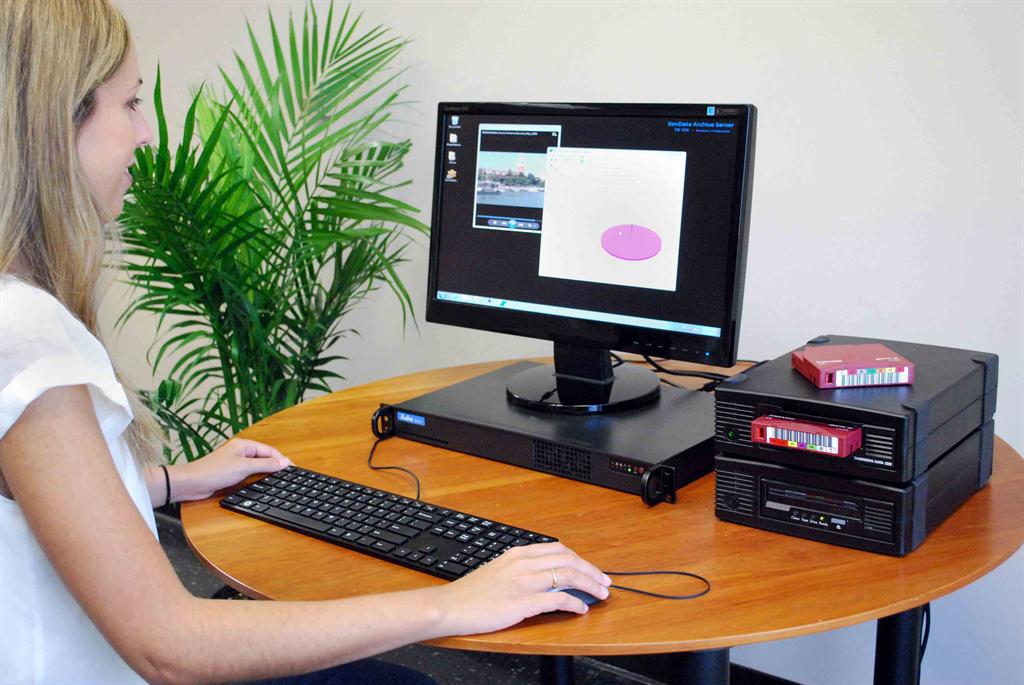LTO-6 Expands Archive Size, Speed

Peter Symes, director of engineering for SMPTE
ALEXANDRIA, VA.—You might have thought that tape formats were dead, a relic of the last century. However, there is one thriving format that still uses ribbons of magnetic tape, and probably will for years to come.
The latest version of this format is called LTO-6 (Linear Tape Open, version 6), and it is used for long-term archiving. Just now supplanting LTO-5, LTO-6 offers more storage per tape cartridge as well as faster transfer speeds.
“This new generation confirms LTO as the preferred storage medium for high capacity long-term video archives,” said Phil Storey, CEO of XenData Corp., a manufacturer based in Walnut Grove, Calif. “LTO provides very reliable storage with a 30-year cartridge lifetime that cost-effectively scales to multiple petabytes.”
LTO archive systems use single-reel continuous-loop 1/2-inch tape cartridges, roughly similar to the old eight-track audio tape cartridges. The cartridges are often referred to as “LTO Ultrium,” and there are recorders that range in size and complexity from simple desktop units to massive robotic systems with mechanical retrieval and loading.
Storey noted that there are two file standards for LTO recording: TAR (derived from Tape ARchive) and LTFS (Linear Tape File System). “[Using one of these formats] ensures that the cartridges will be readable by multiple applications for decades to come and avoids being locked into one manufacturer’s proprietary format,” he said.
LTO-5 tapes have a capacity of 1.5 TB and can transfer data at 140 MBps. With LTO-6, the cartridge’s native capacity jumps to 2.5 TB, and the data rate climbs to 160 MBps. Both standards support compression, resulting in a single LTO-6 cartridge storing more than 50 hours of HD video at 100 Mbps.
COMPATIBILITY
As with previous generations of LTO, drives are read/write compatible with the previous generation and read-only compatible with cartridges from two generations back. This means that LTO-6 drives read from and write to LTO-5 cartridges, and can read from LTO-4 cartridges that can hold up to 800 GB.
With the cost of flash drives and hard drives dropping even as their size increases, some might see the need for tape archives to be limited to a few customers with specialized content. Do mainstream networks and video producers need to be aware of tape archiving technology?
“Absolutely,” said Bruce Master, a senior program manager for IBM, one of three companies in a consortium called the LTO Program. “Tape technology will continue to evolve and tape will maintain its natural advantages compared to disk, such as price, reliability and off-line protection.” Even with video increasingly being stored on the “cloud,” there is still a significant role for tape archive systems.
“Much of the cloud currently uses tape as part of the infrastructure and we expect this to grow, said Laura Loredo, marketing program manager for HP, another member of the LTO Program. “Tape provides the lowest-cost storage tier for archiving and long-term data retention. For this reason, tape is perfect for the cloud where big amounts of data are archived for long periods of time.”
XenData SX-10 LTO archive appliance managing two LTO-6 tape drives. The member companies of the LTO Program (IBM, HP and Quantum), as well as companies such as XenData, SGL, Tandberg and others have LTO products and support interchangeability among each other. SMPTE has standards for video archiving, but these are not specifically related to LTO technology.
“SMPTE is engaged in a major development of the Archive Exchange Format (AXF),” said Peter Symes, director of engineering for SMPTE. “AXF is a wrapper that provides support for archiving on any medium or file system, spanning across multiple media units, such as tape drives. It facilitates migration to new storage formats, as well as recovery on any AXF-compliant system, even if the original system vendor is defunct.”

LASTING STANDARDS
SMPTE is used to developing standards for the long haul, and must anticipate technology that does not yet exist. For this reason, Symes said that AXF is compatible with a variety of media and file systems, including the LTO series, and has features that allow AXF to be extended to new physical formats as they arise.
Within the industry, vendors crave standards—as long as they don’t get in the way of innovation.
“We feel that standards are very important to ensure that the industry is not littered with myriad proprietary formats that offer end-users very little value for money in terms of the longevity and inter-connectivity of the solutions they purchase and implement,” said Nik Forman, marketing manager for U.K.-based SGL, a manufacturer of archive management software. “However, we also like to think of ourselves as thought-leaders in content archiving, and we are constantly developing new features and solutions within our product range that really break new ground.” SMPTE believes that there is room in the AXF definition to permit innovation and new features.
“AXF will offer advanced and extended features that cannot be provided by any single medium or file system,” Symes said. “Given the requirement of recovery over very long time periods, SMPTE anticipates enhancing the AXF standards with utilities designed to recover AXF archives on standard computers, even in the absence of an archiving system.”
With the growth of cable networks and over-the-top outlets for video, demand is reportedly on the rise for archiving systems. There is simply more video today, and more being created every day.
“Archiving by the broadcast, media and entertainment segments is steadily increasing as more and more organizations move to file-based workflows,” Forman said. “Although disk is still the main choice for short-term storage, it can be expensive and people like to move less mission-critical content to a long-term, low-cost storage medium.”
Bruce Master, senior program manager for IBM With the near-ubiquitous presence of flash memory and disk drives, it’s important to remember that recording on tape results in certain characteristics that differ considerably from flash and disk storage. The biggest difference is that flash and disk storage can access data randomly, while tape systems demand that you shuttle through the tape to locate the necessary data.
This makes tape storage much slower than disk storage when it comes time for retrieval. Most experts recommend a mix of disk and tape storage for archives, putting the most-often retrieved material on disk for the fastest access.

LEVEL OF PROTECTION
One big benefit of tape storage is that individual tape cartridges are offline and not susceptible to attacks from hackers or data thieves. This gives the data a level of protection much greater than that of a connected disk drive.
The amount of video content has been growing rapidly in the past decade, and there now exists more than a century’s worth of moving images and sound. If you create content, at what point should you start thinking about long-term archives?
“The size of your data library shouldn’t really be the deciding factor—good archive systems are flexible and scalable, which means that those without huge amounts of data can start small and expand as their requirements dictate,” Foreman said. “Quite often, however, we find that people only get around to thinking about archiving when it’s too late, and they have lost data. You never realize just how much your content is worth until you lose it.”
With the LTFS file standard, archiving on tape uses familiar computer operations known to just about anyone who touches a mouse and keyboard. “LTFS essentially is a file system on tape that can allow viewing and access of tape files in a fashion like using disk or other removable media,” said Paivi Juvonen, segment marketing manager for San Jose, Calif.-based manufacturer Quantum. “It provides directory tree structures, along with drag-and-drop capability. The result is that tape is easy to use and portable across different hardware and software platforms.”
Now that LTO-6 is available, can LTO-7 be too far behind? Actually, the industry has already begun planning for both LTO-7 and LTO-8, which will almost certainly continue the trend of greater capacity and faster transfer speed.
So don’t write off tape just yet. There is still a role for tape in the video industry, even as dozens of old videotape formats slip into distant memory.
For more information on LTO and LTFS, check out our ebook on the subject: LTFS: A New Way to Archive
Get the TV Tech Newsletter
The professional video industry's #1 source for news, trends and product and tech information. Sign up below.
Bob Kovacs is the former Technology Editor for TV Tech and editor of Government Video. He is a long-time video engineer and writer, who now works as a video producer for a government agency. In 2020, Kovacs won several awards as the editor and co-producer of the short film "Rendezvous."

